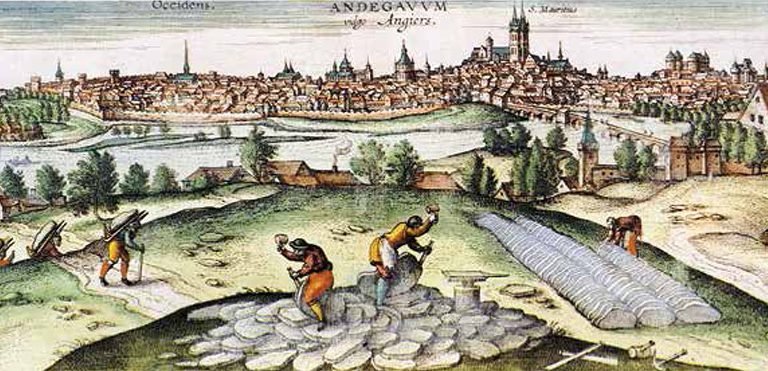Company > History >Historical value of the slates of Bernardos > Searching for the material

For these reasons, the area of Santa María de Nieva was selected to supply the works located in Segovia. The miners who arrived to extract the slate prospected the area and selected Bernardos − 10 kilometres away from Santa María − as the most suitable. For the works undertaken in Madrid, they chose to extract in the vicinity of Torrelaguna, and the area of Yébenes was considered the most adequate for the works under way in Toledo.
However, the works in Madrid faced an obstacle when the searches for slate around that area failed to produce positive results. In the construction of the Royal Alcázar of Madrid and the Royal Palace of El Pardo, the slate used was extracted in the Bernados quarries, due to the inadequacy − decisively demonstrated in 1563 − of the samples obtained in the Torrelaguna area. By however, Yébenes seems to have provided good material for the works in Aranjuez, but there is no evidence to suggest that slate from that area was used for the constructions in Madrid.
The search for alternative locations continued while works began for the Monastery of El Escorial. The area of Cebreros was examined, and it appears that the French experts found acceptable material. In fact, slate was extracted from the socalled quarry of La Palomera for a few months. The extraction therein stopped soon after, but it is still unknown whether this was due to adverse local weather conditions or to the fact that the slate was not sufficiently good.
A similar situation emerged after the fire of 1671, which damaged most of the roof. Slate was extracted from a quarry located seven leagues away and brought to be tried on the roof, but it was ultimately rejected by the members of the Committee on Constructions and Forests who were in charge of the reconstruction:
“Although it can be found a mere seven leagues away from this Royal House and although we would be obliged to travel fifteen leagues to obtain slate from Bernardos, the latter shall prove a better price. The nearby slate is too soft and cannot be fashioned into sheets as thin as that from Bernardos, for only the experts living in Bernardos know how to adequately extract slate. It would eventually be more costly to use the nearby slate, so it is fitting to continue bringing the slate from the same quarry which we have been using until now…”
(5) AGS, CC y SS. Reales, leg. 247: 1 f. 60 “En Torrelaguna y su contorno se hizo ensayo de las muestras de pizarra que allí se hallaron y pareció al sacador que ninguna dellas era de provecho -aunque la una de ellas tenía buen color, pero no hienden bien ni se dejaban cortar al propósito de lo que es menester”. Sobre la zona toledana se había presentado una “Memoria de la pizarra buena que hay cerca de Yébenes para que cuando haya buen aparejo se provea que se comience a sacar poco a poco y se traiga a Aranjuez y donde más S.M. fuere servido”.
(6)Cano de Gardoqui, (1994:172-3). Un siglo más tarde, tras el incendio de El Escorial en 1671 se volvió a intentar traer pizarra de una zona situada a la mitad de trayecto que Bernardos, que podría ser otra vez esta cantera en Cebreros, pero se desechó por resultar blanda.
